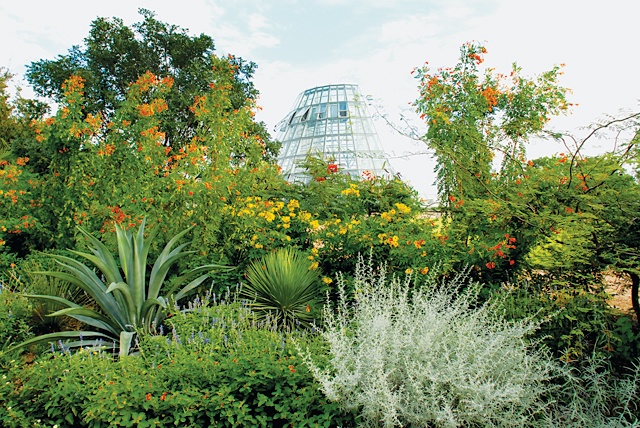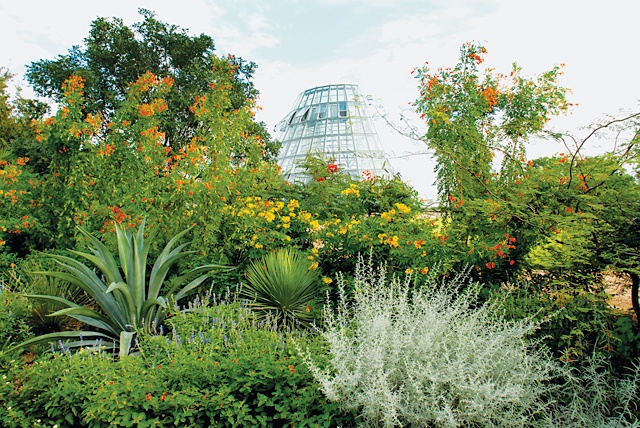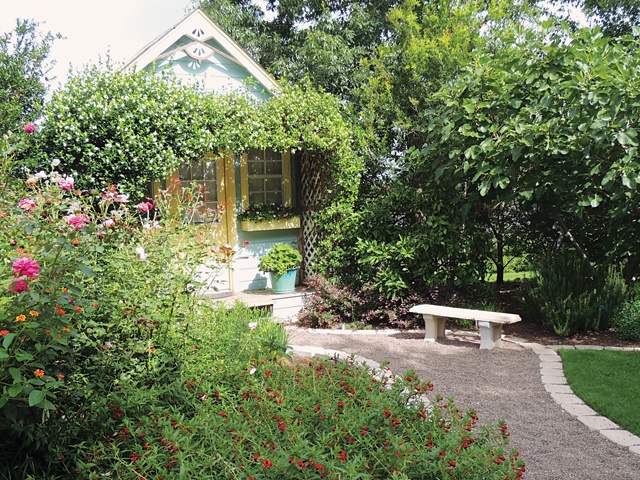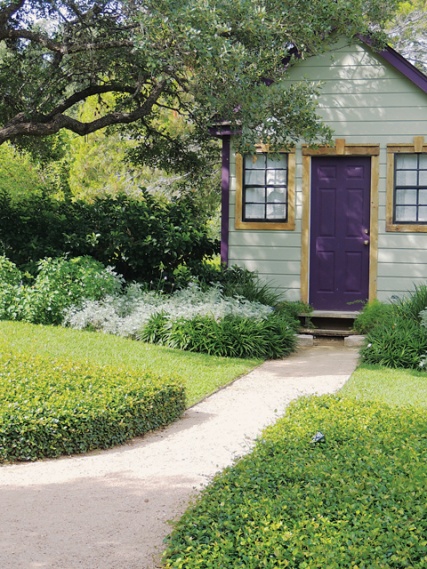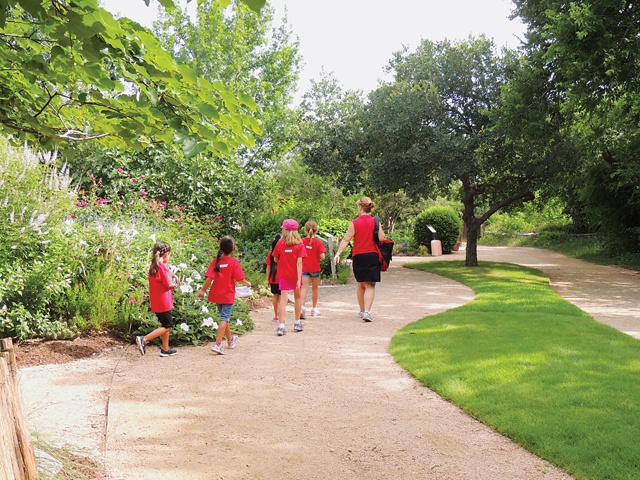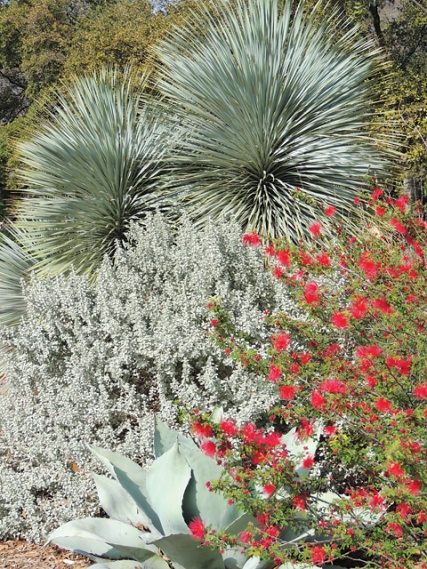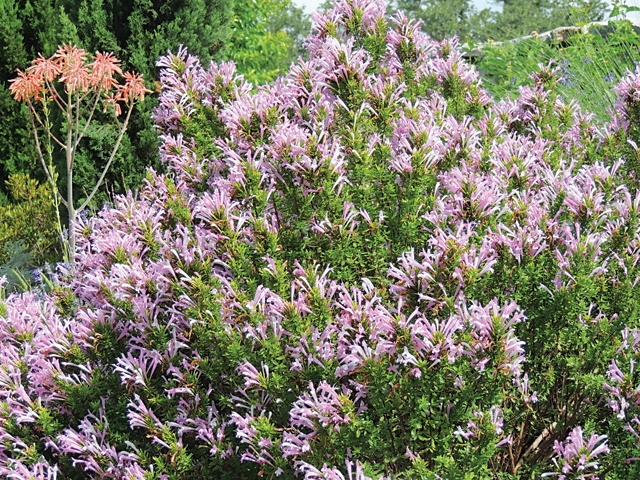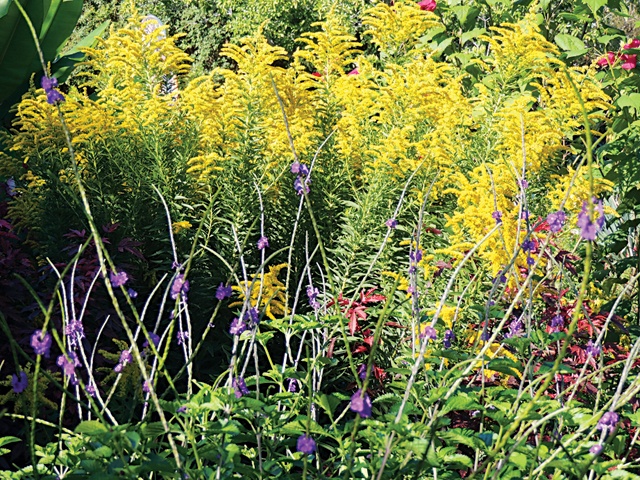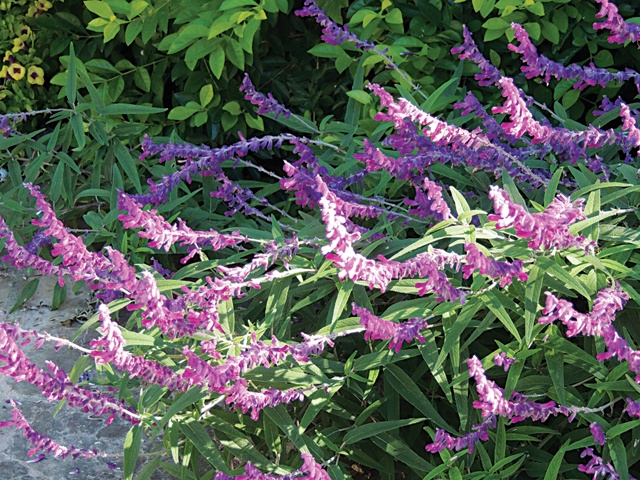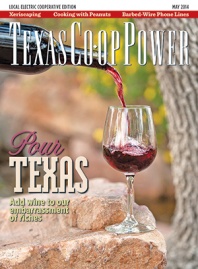A walk down WaterSaver Lane at the San Antonio Botanical Garden takes only a few minutes, but that’s long enough to get a bonanza of ideas for reducing water use without sacrificing a beautiful and inviting landscape.
With the assistance of the San Antonio Water System, the garden has created six model landscapes that offer a variety of approaches to using drought-resistant vegetation. WaterSaver Lane is one of many educational efforts in parched San Antonio, where the population has grown by 52 percent since 1984, but water use has increased only 21 percent, according to the city’s water utility.
Sasha Kodet, the botanical garden’s education director, takes me on a tour of several sample gardens and explains that water-thrifty yards don’t have to be rocky and forbidding.
One of the first lawns Kodet shows me is the Traditional American Lawn, one of the most common Texas yards. It relies on St. Augustine, the greediest of all turfs that uses more water, fertilizer and pesticides than other lawn grass, according to Kodet. It’s close-cropped and needs watering once a week during the growing season.
Farther down WaterSaver Lane, we’ll see yards with less turf and more patios, perennial flowerbeds, herb gardens and groundcover.
Before we get there, it’s time to consider why we should care. Of course, there is saving money. Many cities are using graduated rates for water use, making it expensive to water lawns and plants.
But what if you don’t mind paying more to keep your St. Augustine lush and green? Well, there’s another compelling reason to save water: Texas is running out of it.
Much of the state is in the midst of an extended drought. Fall rains provided significant relief to some areas, giving the impression that things aren’t so bad. However, a little perspective shows otherwise. Texas State Climatologist John Nielsen-Gammon of Texas A&M University explains that drought conditions affected half of the state in November 2013. “That’s a smaller percentage than at any time since the current drought began in late 2010,” Nielsen-Gammon says.
But you need to consider, he adds, that “in the western half of the state, several consecutive years of drought have continued to deplete water stored in reservoirs and aquifers. Despite all the rain in the eastern half, statewide reservoir storage is only about 63 percent of capacity, while in a normal year it would be about 80 percent. The long-range forecasts aren’t especially favorable, and normal rain isn’t sufficient in West Texas to replenish water supplies.”
Across the state, the No. 1 use of water is irrigation. “That water is ultimately being used to feed people,” says Nielsen-Gammon. “Urban irrigation, or watering, is the largest use of water within cities, but unlike irrigation for food, urban irrigation is more like simply pouring water on the ground.”
He explains that in a large urban area, a 20 percent reduction in irrigation could eliminate the need for an entire new reservoir. Water-saving practices in the yard are among the least punishing and most rewarding ways to address shortages that will only become more acute.
The now-common term for such conservation efforts is xeriscaping, a concept developed in 1981 and copyrighted by the Denver Water Department. Xeriscaping sets you free from the traditional lawn. Imagine less mowing, or no mowing at all, and winding paths through glades of perennial flowers with transitions to dramatic grasses or shrubs.
Depending on the size of your property, you might want to think of the outdoor area as different rooms. You can have an area for succulents leaning against rocks, especially if you have a slope for good drainage. You can have crushed granite or pebbles for walkways or even geometric sections divided by brushed steel for a clean, modern look. You can have an outdoor living room and a kitchen annex.
Back on WaterSaver Lane, Kodet shows me the Manicured Xeriscape Landscape, which is similar to traditional American lawns. It provides the same neat, clean appearance but substitutes less thirsty grasses and ground cover for St. Augustine. I get one idea for my yard, which is to plant privet, a perennial shrub, in an area where I once had St. Augustine and keep it cut low.
The Texas Hill Country Landscape is great for areas with thin, alkaline soils. This yard uses natural rock outcroppings and leaves some areas as natural habitat. (This could take on a desert look.) For the most part, it is water-wise to use perennial plants (ones that come back year after year) rather than annuals that have to be replanted or reseeded yearly. Wildflowers are the exception. They must be reseeded every year, but they adapt so well to the natural landscape and need so little attention that xeriscapers endorse them. The more native plants used, the less watering is required.
On to the Wildscape Landscape, designed to attract wildlife and insects that need a variety of food—nectar, seeds and berries. As in the Hill Country landscape, native plants are used because they handle periods of drought better than most imports.
The Cottage Garden, or kitchen garden, is a part of every culture. Designs may change around the world, but there is a practical use for every planting, whether for cut flowers, herbs, vegetables or fruit. It’s rather a hodgepodge, but your eye can be directed to a trellis or a birdbath or a garden bench.
Last, we see one of my favorites, the Spanish Courtyard. I’ve already adopted this look in my backyard. Designed as an extension of living space, a patio made of brick, stone or crushed rock is set in decorative patterns. I have a recirculating fountain. It loses some water to evaporation but nowhere near as much as a lawn sprinkler. Birdbaths provide an interesting sculptural look. Vegetation is usually limited to the periphery or large pots.
Xeriscaping has an option for just about everyone. For myself, I’d rather be filling a birdbath, watering a few plants in big pots and topping off the fountain than mowing and weeding and putting in a lawn irrigation system. Besides, I enjoy my yard a lot more knowing I did my part to conserve Texas’ water.
Visit sabot.org to learn more about the San Antonio Botanical Garden’s WaterSaver Lane.
——————–
Kaye Northcott is a former editor of Texas Co-op Power.
